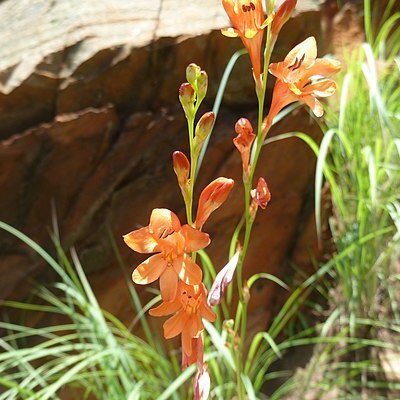Plants (200-)300-600(-800) mm high. Corm subglobose, 15-30 mm diam., sometimes deep-seated; tunics of fine-textured fibres, sometimes with a papery neck. Stem erect or inclined outward above, usually unbranched or 1-or 2-branched from near middle. Leaves 4 to 8, linear, suberect in a loose fan, weakly twisted toward tips, as long as stem or slightly longer, (50-)100-300(-450) x (1-)2-4(-6) mm, acute to acuminate, striate with main vein moderately thickened and with 3 or 4 other vein pairs also slightly thickened, without prominently thickened submarginal vein, cauline leaves smaller and sheathing, uppermost sometimes concealed by upper foliage leaf. Spike suberect, moderately lax, subsecund, 5-to 12-flowered; bracts dry-membranous, translucent or purplish, flushed dark reddish brown, speckled in upper 1/3 or at tips, outer (6-)8-12(-15) mm long, acute or 3-toothed, inner ± as long or shorter, bifid. Flowers zygomorphic, reddish orange to bright red with pale yellowish throat and yellow spot on lower tepals surrounding callus; perianth tube obliquely funnel-shaped, 10-15 mm long, lower cylindric part 3-6 mm long, widening up to 6-8 mm diam.; tepals unequal, obovate, dorsal larger and slightly hooded over anthers, often paler inside, upper laterals spreading and lower tepals deflexed, upper tepals 13-18 x 5-10(-15) mm, lower tepals 10-15 x 5-8 mm, each with a quadrate yellow callus 2-4 mm high near base. Filaments unilateral, arcuate, 12-14 mm long, shortly exserted up to 6 mm; anthers 5-6 mm long, often curved, cream-coloured to violet. Style dividing opposite upper 1/2 of anthers, branches 2-3 mm long. Capsules subglobose to shortly ellipsoid, 7-10 mm long.
More
An erect herb. It arises from a round corm. The corm is covered with fibres. There are 4-8 leaves that are narrowly sword shaped and spread out like a fan. They have a slender base. The flower spikes have 2-20 flowers. The flowers are 25 mm long and are trumpet shaped and orange-red. The fruit is an oval capsule. The seeds are round and light brown.
Geophyte, up to 0.9 m high. Perianth tube (10-) 14-18 mm long. Leaves striate, suberect or slightly spreading, linear, acuminate, firm, 450-900 x 1.5-4.0 (-6.0) mm. Flowers light flame-to bright orange-red or bright red with a high greenish yellow callus on each anticous perianth segment.

